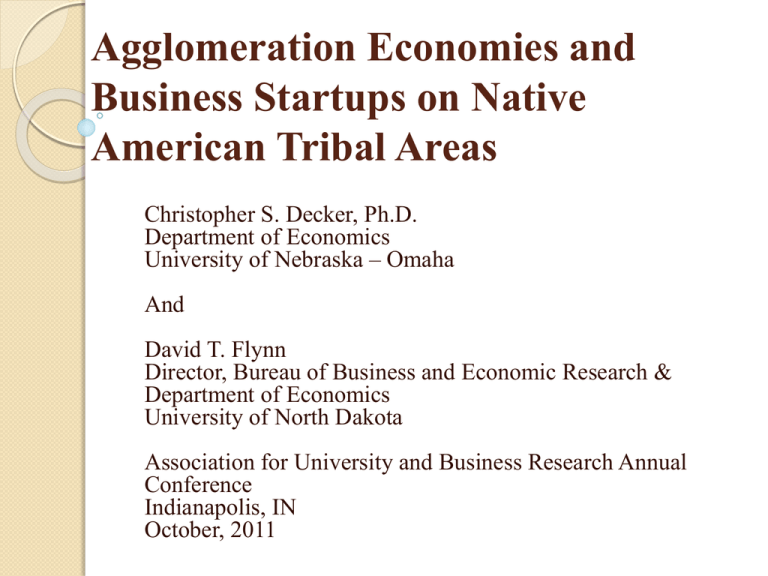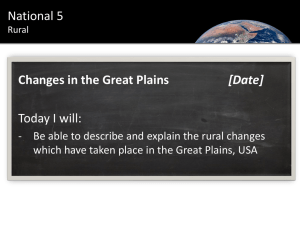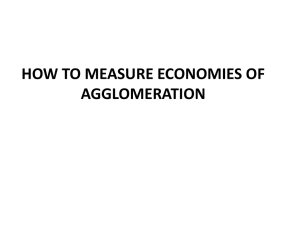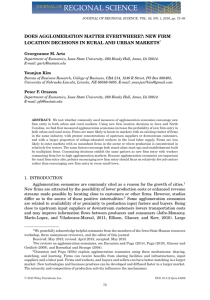CDecker_Business Startups on Native American Tribal Areas
advertisement

Agglomeration Economies and Business Startups on Native American Tribal Areas Christopher S. Decker, Ph.D. Department of Economics University of Nebraska – Omaha And David T. Flynn Director, Bureau of Business and Economic Research & Department of Economics University of North Dakota Association for University and Business Research Annual Conference Indianapolis, IN October, 2011 Motivation Long-term phenomenon: Poverty rates are higher in non-metropolitan than metropolitan regions (Fisher, 2007) On Native American Indian reservations poverty rates can be triple the national average (Benson, Lies, Okunde, and Wunnava, 2011) Recent (anecdotal) evidence identifying several instances of successful enterprises on Native American Indian reservations of the Great Plains (Clement, 2006) Questions What are the determinants of business startups on Native American Indian reservation areas? How does this compare with non-Native American rural areas? Focus: the role “Information Technology” agglomeration (IT agglomeration) plays Focus: State of South Dakota Why South Dakota? Home to many Native American tribes ◦ Cheyenne River, Pine Ridge, Rosebud, Yankton, Lower Brule, Crow Creek, and parts of the Standing Rock and Sesseton Boundaries (roughly) follow county lines ◦ According to Leichenko (2003) ◦ Much of the available data is county-level Native American counties in South Dakota historically among the poorest in the nation Yet, they have experienced substantial improvement in recent years ◦ Example: Shannon County (Pine Ridge Sioux) Native American Rural Counties: Leichenko (2003) Annual Growth in Business Starts – County Aggregates (NETS) Share of Rural Startups Located in Native American Counties (NETS) Business Startups in Native American Counties: 2000 - 2007 (NETS) Total Key Sectors Health Care Waste Management and Remediation Services Retail Trade Professional, Scientific, and Technical Services Construction Accommodation and Food Services Wholesale Trade Real Estate and Rental and Leasing Arts, Entertainment, and Recreation Transportation and Warehousing Educational Services 1,782 248 227 136 134 119 59 56 55 52 45 45 Business Startups and Agglomeration Economies A common reason for lackluster growth in rural economies has been that they tend to lack agglomeration economies (Gabe, 2003, 2004; Carlino, 1980) ◦ Lack ready access to productive capital ◦ Limited access to educated, skill-relevant and experienced labor force ◦ Limited transportation and communication infrastructure Recent Research and Agglomeration Yet, evidence suggests some substantial growth in rural business starts Recent research (e.g. Decker, Thompson, and Wohar, 2009; Domazlicky and Weber, 2006; Latzko, 2002) suggests that traditional measure of agglomeration (such as population density, etc.) may be playing a less critical role in regional economic development Perhaps a Refined Measure of Agglomeration Would be Helpful Clement (2006): examples of new Native American businesses that exploit Computing and Information Technology (IT) to promote consumer outreach and sales growth Suggests that local economies taking advantage of IT development ◦ Inexpensive computing equipment ◦ IT labor skills more prevalent, easier to acquire ◦ Software written to be more generally accessible and relevant to a broad number of industries Can lead to greater geographic dispersion of IT-related capital and labor skills “IT” Agglomeration Le Bas and Miribel (2005) constructed an IT Agglomeration measure Identified industries which appear to rely heavily upon, or have increased their usage of IT and IT-related inputs in recent years Found that IT Agglomeration significantly enhanced labor productivity in existing firms Le Bas and Miribel’s IT agglomeration Based on employment data by industry Comprised of a variety of different sectors ◦ Computer & electronics, wholesale trade, information services, financial services, professional services, educational services Common concentration measure (used in our paper) : IT “Location Quotient” E M Pi , IT IT _ L Q EM P i ,T O T E M PSD , IT E M PSD ,T O T Model Variables Model variables and construction follow Gabe (2003, 2004) Dependent variable ◦ STARTi,t – new business starts in county i, year t Independent Variables (one year lag) ◦ IT_LQi,t-1 – IT Location quotient (+) ◦ ESTABi,t-1 – number of establishment in operation (+) ◦ TAX_INCi,t-1 - ratio of tax revenue to personal income (-) ◦ SPEND_POP-,t-1 – government spending per capita (+) ◦ WAGE_WAGESDi,t-1– relative per capita wages in county i to SD (-) ◦ NL_NLSDi,t-1– relative non labor costs to SD (-) The General Model ST A R Ti , t f ( E ST A B i , t 1 , T A X _ IN C i , t 1 , SP E N D _ P O Pi , t 1 , W A G E _ W A G E SD i , t 1 , N L _ N L SD i , t 1 , IT _ L Q i , t 1 , i , t ). Note: independent variables enter estimation in natural log form to facilitate interpretation of coefficients as elasticities The DATA…. Covers the period 1990 to 2007 annually STARTS, ESTAB, all employment data – National Establishment Time-Series database (NETS) – Walls and Associates Population and income data – Regional Economic Information Service (REIS) – BEA Tax revenue and government spending data – Census of Governments (various years) The DATA…. Two panel data sets ◦ Native American Counties ◦ South Dakota Rural, non-Native American Counties Native American Counties Bennett Buffalo Charles Mix Corson Dewey Jackson Roberts Shannon Todd Ziebach Non-Native Rural American Counties Codington Day Gregory Hughes Hyde Lyman Marshall Mellette Moody Stanley Tripp Walworth Aurora Beadle Bon Homme Brookings Brown Brule Butte Campbell Clark Clay Custer Davison Deuel Douglas Edmunds Fall River Faulk Grant Haakon Hamlin Hand Hanson Harding Hutchinson Jerauld Sully Jones Yankton Kingsbury Lake Lawrence McPherson Miner Minnehaha Perkins Potter Sanborn Spink The DATA…. Native American Counties ◦ 1990 - 2007 ◦ Average number of Starts: ◦ Average number of Establishments: 185 2,971 Non-Native American Counties ◦ 1990 - 2007 ◦ Average number of Starts: ◦ Average number of Establishments: 3,421 49,280 Estimation Procedure 1. Following Gabe (2003) – model STARTS using models applicable to count data ◦ Poisson vs. Negative Binomial ◦ Fixed Effects vs. Random Effects 2. OLS – dependent variable: ln(STARTS/ESTAB) ◦ Not uncommon ◦ Intuitive appeal ◦ Restricts ESTAB’s effect to be unit elastic Estimation & Specification Wu-Hausman test favors the Fixed Effects model over the Random Effects model Count models: ◦ Poisson – conditional mean = conditional variance Restriction caused by the model ◦ Negative Binomial (NB) – conditional mean > conditional variance ◦ Applicable when data is over-dispersed Failure to account for over-dispersion can lead to inflated standard errors Likelihood Ratio tests favor NB NB model estimation results Native American Counties Constant ln(ESTAB) *** ln(IT_LQ) *** ln(TAX_INC) * ln(SPEND_POP) *** ln(WAGE_WAGESD) *** ln(NL_NLSD) No. Obs Log likelihood Wald χ2(6) LR statistic - Poisson restriction test Standard errors reported in parentheses * - 10 percent significance ** - 5 percent significance *** - 1 percent significance *** -4.85 (1.68) 0.73 (0.24) 1.15 (0.51) -0.31 (0.12) 0.13 (0.13) -0.21 (1.21) -0.22 (0.11) *** *** ** ** ** 160 -483.87 24.91 *** 147.24 *** Non-Native American Counties -2.92 (0.80) 0.45 (0.10) 0.38 (0.13) -0.48 (0.09) 0.38 (0.08) -0.42 (0.34) -0.08 (0.05) *** *** *** *** *** * 833 -2,875.54 99.15 ** 1821.00 *** OLS Results: ln(STARTS/ESTAB) Constant ln(IT_LQ) ln(TAX_INC) ln(SPEND_POP) ln(WAGE_WAGESD) ln(NL_NLSD) Native American Counties -5.41 *** (1.23) 1.53 ** (0.67) -0.28 ** (0.14) 0.10 (0.14) -0.04 (1.40) -0.20 (0.13) No. Obs F-stat 2 R Standard errors reported in parentheses * - 10 percent significance ** - 5 percent significance *** - 1 percent significance Non-Native American Counties -5.17 *** (0.52) 0.41 *** (0.17) -0.44 *** (0.11) 0.35 *** (0.09) -0.50 (0.44) -0.10 * (0.05) 160 2.15 * 833 8.21 *** 0.11 0.14 Preliminary Research Extensions Startups don’t necessarily translate into regional success Survival characteristics of rural businesses versus metropolitan area businesses ◦ Agglomeration economies (as traditionally defined) would favor metropolitan concerns Survival characteristics of Native American rural businesses versus non-Native American rural businesses ◦ Reasons for difference? Perhaps minority access to financial capital? Rural vs. Metropolitan Area (NETS) Rural survival rates higher than metro (reg1 = rural) Native American versus non-Native American (NETS) Nat. Am. survival rates higher than non-Nat. Am. Conclusion IT Agglomeration seems to stimulate business startups Marginal impact higher in Native American Indian Counties Survival characteristics of rural vs. metro businesses in SD Survival characteristics of Native American vs. non-Native American rural businesses Full-parametric analysis would be helpful.










